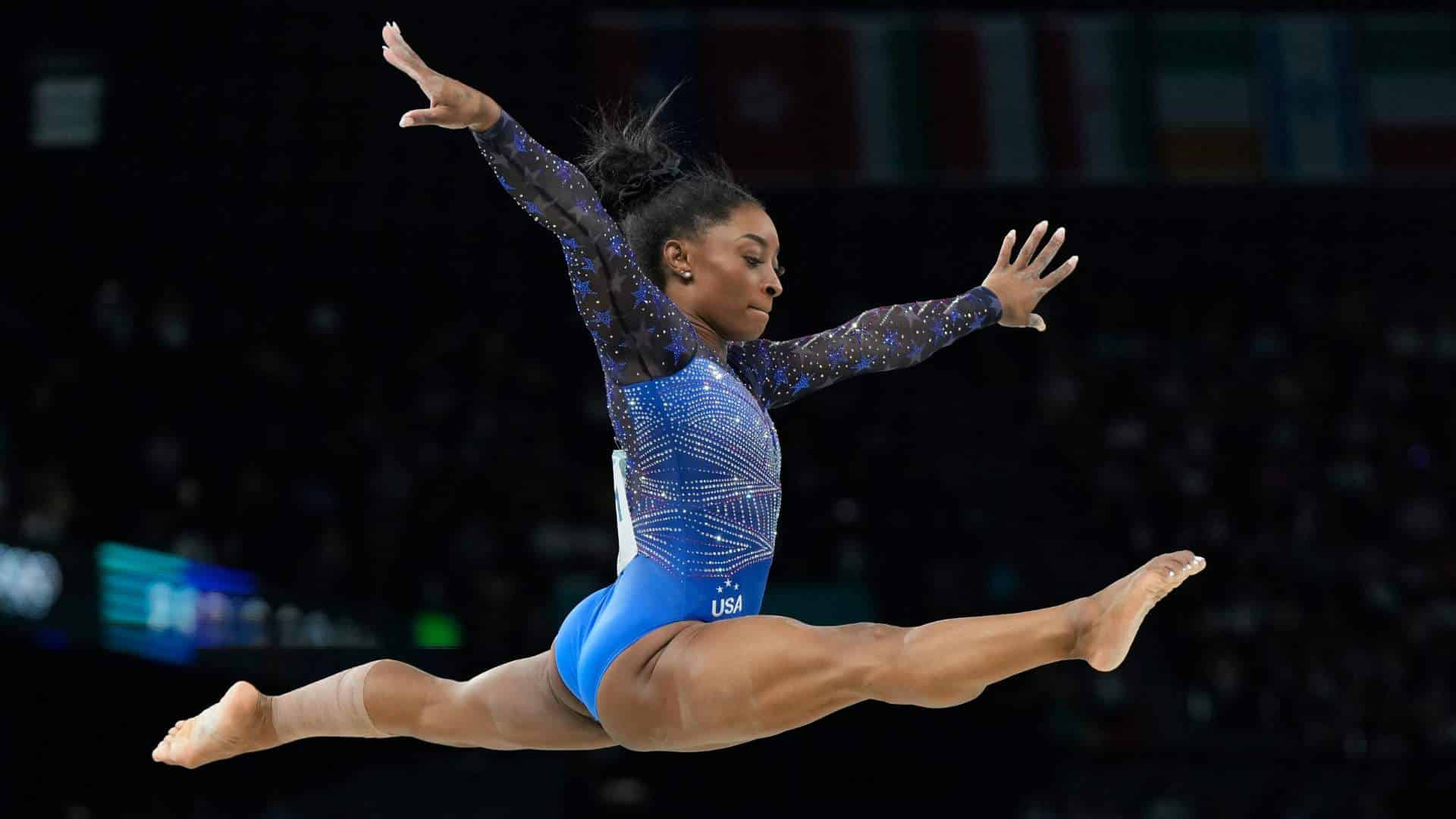Olympians can nail double backflips on a mat or 360 flips on boards. But when they train, they also go to bed early and stay off social media. Can you do that?

Gymnast Simone Biles, of the United States, performs on the balance beam during the women’s artistic gymnastics all-around finals in Bercy Arena at the 2024 Summer Olympics, 1 August 2024, in Paris, France. (AP Photo/Francisco Seco)
This article was produced exclusively for News Decoder’s global news service. It is through articles like this that News Decoder strives to provide context to complex global events and issues and teach global awareness through the lens of journalism. Learn how you can incorporate our resources and services into your classroom or educational program.
Four-time Olympic gold medalist Venus Williams once said that training and preparation are everything in sports. “You have to train your mind as much as your body,” she said.
Olympic athletes arrived in Paris this summer in superb physical condition, their bodies intricately tuned for peak performance. Just as important was their mental preparation.
“There’s not more build up, anticipation or peak to somebody’s career than that,” said Dr. Adam Shunk, sports psychologist and 2006 U.S. indoor high jump champion. “When you’re at that level to make a team or possibly medal at the Olympics, you train for that moment for four years, so that creates some incredible challenges.”
The demands and expectations of the Olympics can take a major toll on an athletes’ well-being. Some of the most prominent Olympians such as gymnast Simone Biles, tennis player Naomi Osaka and swimmer Caleb Dressel have stepped away from their respective sport to take mental health breaks.
The mental toll on the athletes can lead to depression after the Olympics and many athletes must continue competing at the international level once the games conclude.
But since those breaks, Biles was able to add three golds and one silver to her medal collection at the Paris Olympic Games. Dressel anchored the men’s 4×100 freestyle relay and came away with two gold medals and one silver in Paris. And Osaka has given birth to a baby girl and is back competing on the Women’s Tennis Association Tour.
The stress of success
The pressure is intense for athletes competing at the highest level. For most Olympic events, it’s the only one an athlete might have, Shunk said. “You get one final, you get three jumps, you get three throws. It really comes down to just four years condensed into that, so the pressure is about as high as you could get in a sports event,” he said.
Managing external factors is also critical. According to the Journal of Sports Sciences, successful Olympians have a high degree of self-confidence, are able to block out distractions, manage their arousal level, are goal-oriented and demonstrate a healthy form of perfectionism.
The factor that separates champions from others might just be the ability to make mental decisions such as going to bed early, staying off social media and avoiding temptations.
Sports psychologists list three types of obstacles to athletes’ mental health.
The first is struggling, where a person simply tries to overcome problems like behavioral habits, relationships, anxiety or depression based upon stressors they experience in life.
In the struggling category, you’ll find everything that can prevent an athlete from performing consistently under routine conditions. Performing consistently under routine conditions is demanding on the athlete.
The next category is surviving. This is the phase where Clinical and Sports Psychologist Dr. Wayne Chappelle would describe the athlete as saying: “I’m adapting, I’m performing, I’m showing up, I’m doing reasonably well and practicing consistently, but I’m not achieving my greatest potential.”
From a mental standpoint, surviving is when an athlete performs well under routine conditions, but when undesirable conditions such as bad weather, poor sleep and less than optimal equipment come into play, the athlete struggles.
From striving to thriving
The third category is thriving, where an athlete not only consistently achieves extraordinary feats based upon their capability but is able to do it in the most undesirable condition. “That’s the difference between choke and clutch performances,” said Chappelle.
Elite athletes accept the precarious nature of their careers and have self-conception that extends well beyond sports. Mastering this gives athletes the ability to weather the storms of low moments more easily.
Michael Phelps, the 23-time Olympic gold medalist, once said “I can only control my performance. If I do my best, then I can feel good at the end of the day.”
It’s important for an athlete to understand what they can and can’t control. Chappelle said that many athletes struggle to delineate between the two.
“You can be at the right time, at the right place, perfectly execute and yet the ball still won’t go in,” Chappelle said. “So, it’s all about focusing specifically on the effort and the movements versus the outcome and valuing what you do based upon how you control what you have control over, which is your effort in your movements, versus what you don’t have control over.”
The highs and lows won’t have the peaks and valleys in terms of emotions if athletes know how to focus exceptionally well on all the things that they can control. They have a greater level of consistency that way, he said.
Aspirations versus expectations
The final component is expectation. Athletes tend to perform better in scenarios where their expectations are realistic. When an athlete expects themselves to perform well, they’re in a better position to exert the energy and effort into it in order to perform.
If an athlete has negative expectations of themselves, they’re unlikely to meet those expectations because of self-fulfilling prophecy and less likely to put in the extra effort that’s needed in order to accomplish the extraordinary. Having those positive, realistic expectations is oftentimes what’s needed in order to energize and motivate an athlete, as well as not overthink, when in the moment.
“When we have unrealistic expectations, we set ourselves up for a lot of disappointment and we set ourselves up for failure,” Chappelle said.
The best athletes are able to act without thinking.
Overthinking can lead to negative expectations, so during this time, it’s crucial to have positive realistic expectations from coaches and teammates. “The best version of oneself is never by oneself. It’s always with the support of others,” said Chappelle.
Managing the people around you
Sometimes it may be those who are close to the athlete that affect expectations. Family members and close friends might inflate their ego, prompting them to have unrealistic expectations about themselves.
Habits or events that get in the way of athletes achieving clutch performances are described as bottle, wallet, zipper temperament, users (also known as wolves), pride, control and commitment.
Bottle represents alcohol or substances, which can be prescribed by a physician, and legally acquired or illegally sold on the street. This includes the inappropriate use of supplements such as growth hormone and testosterone.
Wallet represents the poor management of money. This usually happens due to excessive spending, financial illiteracy or letting other people manage it. Zipper is saying and doing things that get you in trouble because of sexual temptations.
Temperament is being unable to regulate one’s emotions such as anxiety, depression, anger, frustration and irritability. Not being able to control one’s temper can cause incidents where emotions lead to actions with regrettable results.
Pride — also known as ego — comes into play when an athlete does what’s best for themselves and not the team.
Knowing who can help or hurt
There are people who can insert themselves into an athlete’s life for nefarious purposes. Called “users” they are typically people the athlete trusts and has personal connections with. Chappelle said that users can be family, friends or significant others.
Shunk agreed that it is important to talk to athletes about the people around them. “You surround yourself by who you want to be,” Shunk said. “Be intentional about who you surround yourself with. It sets you up for success or creates more challenges that you’re going to have to navigate.”
The last habits are control and commitment where an athlete tries to control what they can’t as well as not commit to the things that will make the athlete better.
Without the correct preparation and mindset, these habits and events can lead to the downfall of an athlete.
For an athlete to be prepared and successful, there’s a sense of humility they must have, in the sense that every day they need to wake up with a growth mindset: What am I going to do today to be extraordinary and what do I need to do differently today in order to help me stay that way because the conditions today are different from what they were yesterday?
These are the questions athletes must ask themselves every day, so that regardless of the results this season, the athlete can look at themselves and say, “I’m a better person today.”
Seeing beyond the sport
Chappelle said that it is important that the individual not only grows as an athlete, but as a human. For an athlete to know that their life is thriving in other aspects outside of athletics makes their situation easier.
“I always tell the athletes that who you are today is different than who you were two years ago,” Chappelle said. “So, who you are at the end of this season should be different than who you are today.”
He will ask an athlete if they are the same person that they were two years ago.“If they say, yes, then I go, ‘Oh, we got a problem’, and then I’ll explore with them why that’s a problem. If they say no, then I emphasize that you’re continually growing,” he said.
The stressors that an athlete will experience over the next year or two are going to hopefully lead them to constantly grow, develop and change. Through growth, the same stressors an athlete saw years ago will be easier to manage or may not be considered a stressor anymore.
There are more measures to success than the number of minutes an athlete plays, the marks they’ve recorded, or the points on the scoreboard.
When an athlete comes in with the mentality that they’re going to be a better person, they will eventually see a return on investment because they’re investing in themselves well beyond the athletic realm. They know that being an athlete is just part of them, but not all of them.
questions to consider:
- What are some mental health challenges top athletes have?
- How can the people around an athlete affect their mental health?
- How do you handle the things in your life that you can’t control?

Lance Roller II is a U.S.-based researcher, data analyst and freelance journalist. He is a graduate of the Dalla Lana Fellowship in Journalism and Health Impact at the University of Toronto.

What are some mental health challenges top athletes have?
Struggling, the cons of the daily life, as to avoid social networks.
Surviving, they are the valleys, because a human is not always perfect and 100% energizable.
Thriving, growth well.
How can the people around an athlete affect their mental health?
Well, if someone is a stressor to an athlete, and is a constant and no way out stressor, the athlete is gonna do his exercises thinking in how to overcome this situation with this person, and this runs out time and focus of the athlete.
How do you handle the things in your life that you can’t control?
Saying it out loud, facing it, saying, ok , I know that I can’t change that, but you are like a cube, you have other sides, so I’d rather come along with this other side.